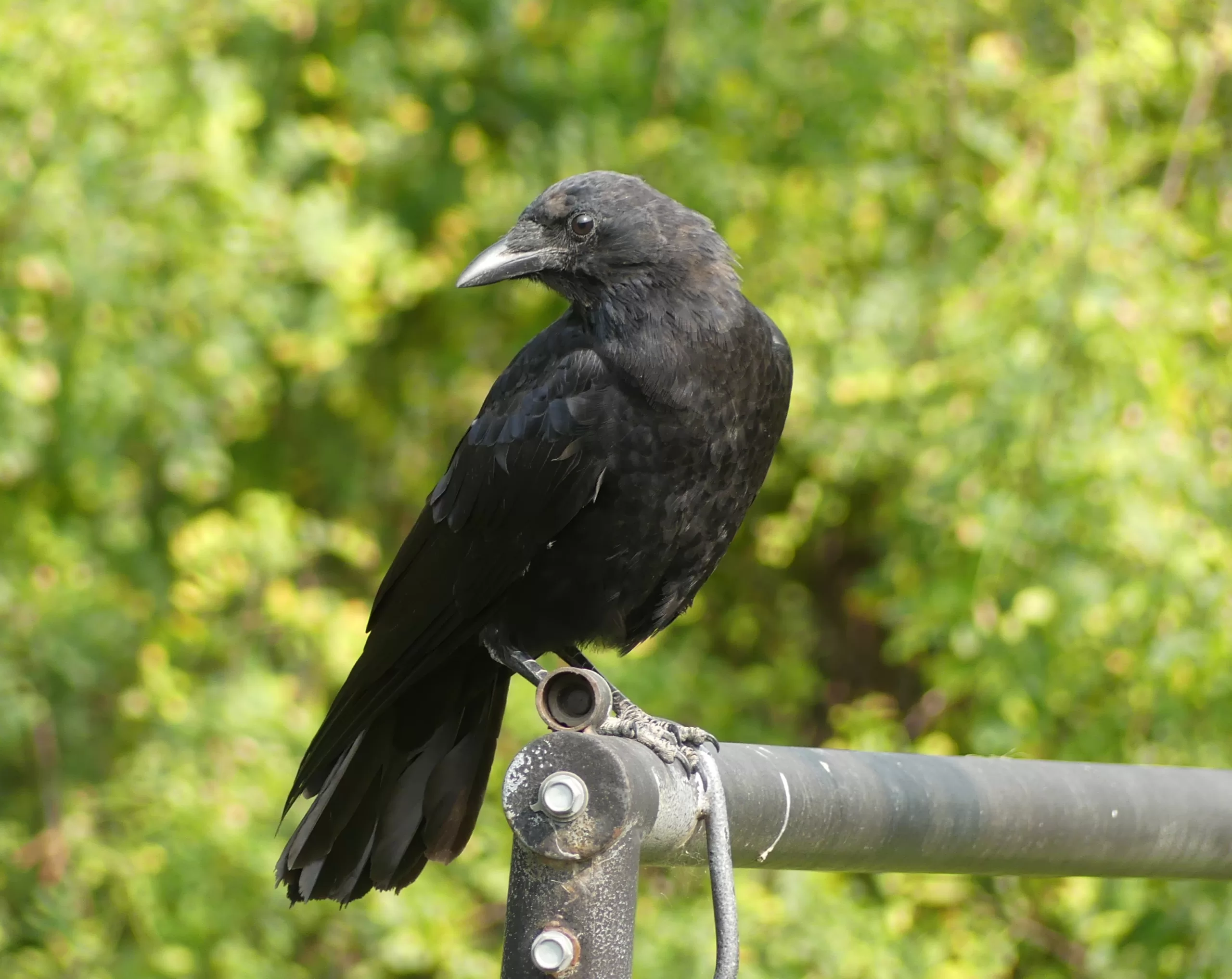Physical Characteristics and Identification
The American Crow is a medium-sized bird known for its distinctive features and adaptability. Key attributes such as size, shape, coloration, and specific identifying traits make this species easily recognizable.
Size and Shape
The American Crow measures about 17 to 21 inches in length. Its wingspan typically ranges from 33 to 39 inches, giving it a robust appearance. The body is compact with a straight bill that is moderately long and thick, designed for versatility in feeding.
Its legs are sturdy, supporting a strong frame that aids in ground foraging as well as perching. Crows exhibit a slight taper towards the tail, which is relatively long and often displayed prominently during flight.
Coloration and Plumage
American Crows are characterized by their entirely black plumage, which may have a glossy sheen under certain lighting conditions. The feathers are smooth and well-aligned, contributing to the bird’s streamlined form.
Young crows may exhibit some brownish tints in their feathers as they mature. In contrast, adult crows maintain a consistent deep black tone that enhances their visual identification in various habitats.
Distinguishing Features
Several features help in distinguishing the American Crow from similar species. Its straight, strong bill is a primary identifier.
Crows also have a distinctive call that is a harsh “caw” sound and can be heard from a distance. The long tail and broad wings further separate them from other corvids like the common raven, which has a wedge-shaped tail.
Its overall size and structure contribute to its unique identity within the Corvus genus.
Behavior and Habitat
The American Crow exhibits a range of behaviors that reflect its adaptability to various environments. Its social structure, vocal communication, and feeding strategies showcase its intelligence and resourcefulness.
Social Behavior
American Crows are highly social birds, often found in flocks, especially during the winter months. These flocks can consist of dozens to hundreds of individuals. In spring and summer, they may form smaller family groups, working together for foraging and protection.
Crows are known for their strong family bonds, often raising young cooperatively. They exhibit behaviors such as mutual preening and play, which enhance social ties. Their interactions can include aggressive displays to protect territory or food, illustrating their adaptability to both urban and rural habitats.
Vocalization and Sounds
American Crows are renowned for their vocalizations, which include a variety of caws, clicks, and whistles. Their calls can carry over long distances, serving multiple purposes, including communication within flocks and alerting others to potential dangers.
Crows have an impressive ability to mimic sounds from their environment, including human voices and other bird species. Their vocal repertoire aids in territorial defense and establishing social hierarchies among flocks. Each individual can have unique call variations, allowing for sophisticated communication.
Breeding and Nesting Habits
The breeding season for American Crows typically spans from March to July. They prefer to nest in tall trees, often selecting locations near water sources. Their nests are built with twigs, grasses, and other materials, showcasing their innovative use of available resources.
Both males and females participate in nest construction and rearing of young. Eggs are typically laid in clutches of three to six and incubated for about 18 days. After hatching, the young remain in the nest for approximately 4-5 weeks, during which they learn essential survival skills from their parents.
Feeding Behavior and Diet
American Crows are omnivorous and opportunistic feeders, adapting their diet based on available food sources. Their diet consists of insects, small mammals, grains, fruits, and carrion. They are often seen foraging on the ground, in fields, and around garbage dumps, showcasing their ability to thrive near human habitation.
In urban areas, crows utilize human food scraps, while in rural settings, they may hunt small animals or forage for seeds. They are known to cache food for later use, demonstrating remarkable intelligence. This adaptability in diet allows them to occupy a wide range of habitats across North America, from forests and fields to city parks.
Diet and Feeding Patterns
The American Crow has a varied diet that reflects its adaptability. It feeds on a wide range of food sources, utilizing its foraging skills and opportunistic nature to access different foods.
Natural Food Sources
American Crows primarily consume a diverse selection of foods. Their diet includes insects, earthworms, nuts, seeds, grains, and fruits. They are particularly fond of carrion, often scavenging from deceased animals. Crows are known to forage in agricultural fields, where they eat grains and seeds, as well as in wooded areas for fruits and insects.
In addition to natural sources, crows readily exploit human environments. They search gardens, parks, and fields, taking advantage of available food. Their intelligence allows them to remember feeding locations and recognize seasonal food availability.
Adaptations for Foraging
Crows possess remarkable adaptations that aid in their foraging behavior. They have strong, dexterous beaks suitable for prying open seeds and fruits. Their keen eyesight enables them to spot food from considerable distances, while their ability to trial and error teaches them how to obtain even difficult-to-reach foods.
Additionally, they can use tools, such as twigs or stones, to access food hidden under bark or inside crevices. This ability to manipulate objects demonstrates their high problem-solving skills. Their omnivorous nature allows them to switch food sources based on availability, making them resilient foragers.
Interaction with Humans
American Crows often interact with humans, particularly in urban settings. They are known to scavenge from garbage bins, compost piles, and outdoor dog dishes for leftovers. This willingness to exploit human waste enhances their survival.
Crows also visit bird feeders and are drawn to offerings of peanuts and other seeds. Their intelligence allows them to learn from human behaviors, making them adept at locating food. This adaptability often leads to them being seen as pests, but they play crucial roles in ecosystems by assisting in decomposition and seed dispersal through their feeding habits.
Share this content:

Post Comment
You must be logged in to post a comment.